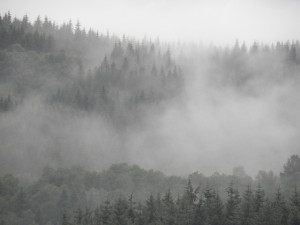Fog over the Forest: How do the land and atmosphere affect one another?
We all know that humans are changing the planet’s surface – deforestation, farming and urbanisation have radically transformed the environment that surrounds us. We also know that humans are changing Earth’s climate, mostly through greenhouse gas emissions, and that the changes we make to the landscape contribute directly towards this, whether it’s through methane released from the ruminants we graze or smoke from our burning of the forests. But what’s less clear is the effect that changes to the climate and atmosphere themselves have on the world’s physical landscape beyond our direct control, and whether this can help to offset or will worsen global warming and further climate change. In other words, will Earth’s surface will provide a ‘negative’ or ‘positive’ feedback to its climate?
Plants can be affected by our greenhouse gas emissions in two ways. As we all know, they take in carbon dioxide during photosynthesis, so we might expect that increased concentrations of the gas in our atmosphere would increase the rate of plant growth, a so-called ‘negative feedback’ because this would draw down more carbon dioxide, locking it up in trees and other vegetation and decreasing the atmospheric concentration again. Studies have shown that this is indeed occurs, at least on a small scale: pumping carbon dioxide into tree plantations to double its concentration produced a twenty per cent increase in plant biomass above ground and a forty per cent increase below ground in a recent Free Air Concentration Enrichment (FACE) experiment.
But the extent to which this will follow through to larger-scale forests and grasslands is unclear. Furthermore, in parts of the world where the climate changes significantly, the excess stress put on plants may hinder their growth – a second, less desirable, effect of our emissions. For example, the Amazon is expected to get warmer and drier, conditions that are less conducive to tree growth and survival. Therefore, a ‘positive feedback’ could develop in some regions whereby climate change induced by greenhouse gasses makes it harder for plants to grow, decreasing the uptake of carbon dioxide. This would switch places like the Amazon from carbon ‘sinks’ to carbon ‘sources’ within decades, even if humans don’t cut down more trees and convert the land to animal pasture.
And it’s not just vegetation we need to account for. The soil itself ‘respires’ through a variety of chemical and biological processes that cause it to give out greenhouse gasses of its own. The amount released changes with temperature and moisture content, and is expected to increase as the world as a whole warms. So whilst Earth’s land surface is at the moment a net sink of carbon dioxide, taking into account both vegetation and soil, it could become a net source by 2050.
This could be counterbalanced, at least initially, by an increased uptake of carbon by the oceans – after all, they are estimated to have already absorbed up to half of the carbon dioxide we’ve emitted since the industrial revolution. More carbon dioxide in the atmosphere means more photosynthesis by ocean plant-life – the microscopic ‘phytoplankton’ in surface waters – and that more of the gas gets dissolved directly in surface waters. But both these effects will begin to fall away as the ocean becomes more saturated with it.
All in all, it looks as though feedbacks from the land and oceans that help to mitigate climate change at the moment will become less and less powerful as greenhouse gas emissions climb. If the ground beneath our feet changes from sink to source, it’s vital that we take into account its interaction with the climate and atmosphere in our projections of future change. But much more needs to be done if we are to understand this fully: as the population expands and land-use is changed directly as well as indirectly by human hands, the feedback effects and its repercussions for our climate, health and survival will become increasingly difficult to predict. One thing that is for sure is that we can’t rely on land-atmosphere feedbacks to provide a buffer against our emissions indefinitely.
![Environmental Damage: Positive Feedback? Fog over the Forest: How do the land and atmosphere affect one another? We all know that humans are changing the planet’s surface – deforestation, […]](/wp-content/uploads/2015/02/Land-atmosphere-640x361.jpg)
